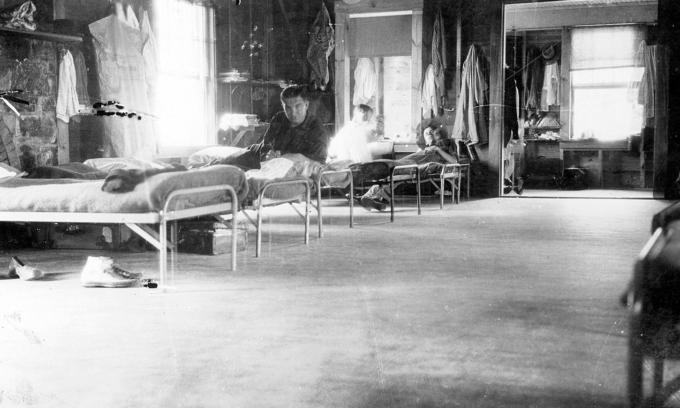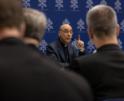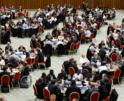
Culture
In 1918, Boston's Cardinal William Henry O'Connell provided the seminary with a long-term solution to "the vacation problem."
A 60-acre tract of land on the shores of New Hampshire's Lake Winnipesaukee was once the site of an unusual summer camp. From 1918 to 1967, it was known as St. John's Seminary Camp, a summer retreat for young men studying for the priesthood at St. John's Seminary in Brighton.
From the earliest days of St. John's Seminary, faculty had struggled with the question of what to do with seminarians during the summer. "A three-months' summer vacation ruins some vocations, harms most and endangers all," one spiritual director wrote in the Bulletin of the Catholic Educational Association. Seminary leaders worried about the lack of spiritual discipline that their students experienced during the summers and the temptations they might face if they returned home. To mitigate the potential risks of a long summer vacation, they experimented with a variety of summer requirements for students, from assigning them to parish work to mandating summer classes on campus.
In 1918, Boston's Cardinal William Henry O'Connell provided the seminary with a long-term solution to "the vacation problem." He granted St. John's the right to use his New Hampshire estate as a camp for the summertime education and recreation of seminarians. From his time in Rome, Cardinal O'Connell was familiar with the villa system of the pontifical colleges, in which seminarians spent summers not at their homes but at country houses owned by their colleges. These villas combined recreation, education, and structured prayer to create a program of priestly formation unique to the summer months. The cardinal sought to replicate this system for the seminarians under his care and to create a model for other American seminaries to follow.
The first seminarians at Lake Winnipesaukee were met with the formidable task of transforming a plot of land consisting of a few old cottages and a boat house into a functioning summer camp that could house dozens of young men and their teachers. Because of the labor shortage caused by World War I, it fell to the seminarians themselves to carry out the bulk of this work.
"To meet the exigencies of the present hour, which demand that every able-bodied man in the nation shall do his full share ... to provide as far as possible for his own personal needs by added effort and economy," a camp circular declared, and "to evidence to others and to ourselves that the Seminary is neither shirking any duty or difficulty under the cover of exemption (from the draft)," seminarians were assigned to manual labor four afternoons per week. Their work was more than fruitful; within its first decade, the camp expanded to include a chapel, cafeteria, recreation hall, priests' house, 10 student bungalows, athletic fields, tennis courts, a shrine to the Blessed Virgin, and outdoor Stations of the Cross.
Even after the war ended and, with it, the labor shortage, seminarians were encouraged to take ownership of their camp's operations. Although seminary faculty lived on site, day-to-day schedules and rules were enforced by student prefects. Similarly, student sacristans were given full charge of the camp chapel and of all services held therein. Rotating groups of seminarians were assigned to serving and clearing meals in the cafeteria. Seminarians were tasked with the upkeep of buildings and with keeping common spaces clean.
In New Hampshire as in Brighton, structured times for individual and community prayer were incorporated into the seminarian's daily schedule. Each day at the camp began with Mass and the exposition of the Blessed Sacrament. After the morning's recreation, seminarians reported to the chapel at noon for the recitation of the Angelus. The community gathered each evening for vespers and benediction. During his episcopate, Cardinal O'Connell himself often oversaw the spiritual exercises of the camp, spending his own summer vacations at Lake Winnipesaukee.
To ensure that students remained academically engaged during the summer, a program of "Villa Studies" was created for the camp. Seminarians would take two classes, four days per week, for the duration of their vacations. One of these courses was always in ecclesiastical Latin; the other depended upon which members of the faculty were present at the camp for the summer months.
Despite their chores, classes, and spiritual responsibilities, seminarians enjoyed ample time for recreation. Their schedule, while regimented, allowed for time to boat, hike, swim, and picnic. During recreation time, they organized into teams and played fiercely competitive games of baseball, tennis, and football. They held boat races on the water and foot races on the land. On Wednesdays, students were permitted to leave the camp for day excursions, provided they went out in groups of at least two, and that they did not hitchhike or visit theaters, movies, or dance halls.
Over the course of decades, little changed at St. John's Seminary Camp. During World War II, the camp expanded an additional 23 acres with the purchase of neighboring Camp Anawan. With these new facilities, for the first time a full summer course load was offered to seminarians in their final three years of study. This program helped to accelerate ordinations, to meet the urgent need for priests caused by the war. After the war, the camp returned to its original two-course program.
In 1965, Pope Paul VI issued a decree on priestly training, "Optatam totius," which stressed the need for pastoral training for seminarians during summer vacations. Candidates for the priesthood were to spend their summers in their communities, working at local parishes whenever possible. Around the time the decree was issued, the seminary was in the midst of a broader restructuring, culminating in the creation of its College of Liberal Arts. It was likely these changes that led Cardinal Richard Cushing to pursue the sale of the Seminary Camp. In 1967, the cardinal personally negotiated the sale of the camp to a New Hampshire probate judge named Kenneth Shaw. Judge Shaw developed the land into a vacation community known as Patrician Shores, a community he advertised as having "without a doubt the most beautiful shoreage on Lake Winnipesaukee."
VIOLET HURST IS AN ARCHIVIST FOR THE ARCHDIOCESE OF BOSTON.
Recent articles in the Culture & Events section
-
'Dignitas' and the mediaRussell Shaw
-
Scripture Reflection for April 14, 2024, Third Sunday of EasterDeacon Greg Kandra
-
St. Helena's House is established in the South EndThomas Lester
-
Is this synodality?Russell Shaw
-
Poking the hornet's nest of IVFFather Tadeusz Pacholczyk


















